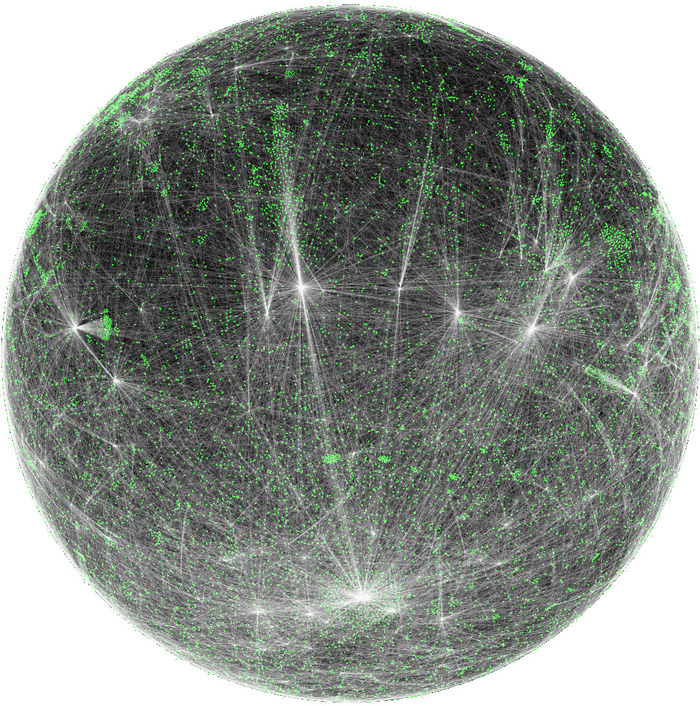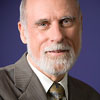February 16, 2012 - Washington, DC Overview and Agenda Photos
NITRD and the Internet
![]() Download Summary
Download Summary
![]() Download PDF Slides
Download PDF Slides
![]() Download Video
Download Video
Summary

The Internet was designed to be a collaborative enterprise. Anyone was free to build a piece of its infrastructure and then find someone willing to connect that piece to the rest of the Internet. Four of the agencies that have participated in the Federal government's Networking and Information Technology Research and Development (NITRD) Program played key roles in the successful implementation and expansion of the Internet. DARPA solely sponsored the initial work until 1981 when NSF took up TCP/IP, X.25 and dial-up phone lines to build its CSNET. In 1985, in a controversial decision to use TCP/IP rather than OSI, NSF launched NSFNET development. DOE and NASA joined later and worked to transition from their DECNET-based systems (MFENet, HEPNet, SPAN) to the TCP/IP‐based ESNet and NSINet, respectively. Beginning in the mid-1980s, the four coordinated their work informally as the Federal Research Internet Coordinating Committee (FRICC). Research efforts that continued to propel the Internet's growth were coordinated through the Federal Coordinating Committee on Science, Engineering and Technology (FCCSET) that was established in 1976 and restructured by executive order in 1976. In 1990, the FRICC was reorganized as the Federal Networking Council (FNC). In 1991, the High Performance Computing Act created what is today known as the NITRD Program and the National Coordination Office (NCO). During the Clinton administration, FCCSET was reorganized to become the National Science and Technology Council (NSTC) with an advisory counterpart: the President's Council of Advisors on Science and Technology (PCAST).
The FNC had as its initial advisory group the FNC Advisory Committee (FNCAC) that continued until 1996 when its functions were transferred to the Large Scale Networking (LSN) Coordination Group within NITRD. The President's Information Technology Advisory Committee (PITAC) was formed in the late 1990s to advise the White House Office of Science and Technology Policy (OSTP) about the entire NITRD program. The FCCSET, FRICC, FNC, NITRD and PITAC activities were among the most germane and effective collaborations within and between government and private sector actors and contributed materially to the successful spread of the Internet into general use.
Over the last 20 years, Internet usage has grown by a factor of 1,000. And as the Internet opened up to the general public, so did information technology capabilities. The greatest demand generator for information technology has been the astonishing growth of the Internet: its widespread adoption has driven demand for an increased number and diversity of software applications that have in turn become increasingly important in all aspects of our lives. And today, the Internet is a significant enabler of human and civil rights. The Internet is a significant success of the Federal investment in networking and information technology research and development.
Moving forward, key challenges will be to pursue important cybersecurity research, in concert with policy makers, in order to ensure that we as technology creators fulfill our obligation not just to empower users, but also to ensure the safety of users online.
Vinton Cerf
 Vinton Cerf is vice president and chief Internet evangelist for Google. Widely known as one of the "Fathers of the Internet," Dr. Cerf is the co-designer of the TCP/IP protocols and the architecture of the Internet. Dr. Cerf, with his colleague Dr. Robert Kahn, Dr. Cerf received the U.S. National Medal of Technology in 1997 for co-founding and developing the Internet. They received the ACM Alan M. Turing award in 2004 for their work on the Internet protocols. In 2005 they received the Presidential Medal of Freedom. In 2008 they received the Japan Prize. Dr. Cerf served as chairman of the board of the Internet Corporation for Assigned Names and Numbers (ICANN) from 2000-2007 and is a Fellow of the IEEE, ACM, and American Association for the Advancement of Science, the American Academy of Arts and Sciences, the American Philosophical Society, the International Engineering Consortium, the Computer History Museum, the British Computer Society, the Worshipful Company of Information Technologists and a member of the National Academy of Engineering. Dr. Cerf holds a Bachelor of Science degree in Mathematics from Stanford University and Master of Science and Ph.D. degrees in Computer Science from UCLA. He also holds honorary Doctorate degrees from 19 universities.
Vinton Cerf is vice president and chief Internet evangelist for Google. Widely known as one of the "Fathers of the Internet," Dr. Cerf is the co-designer of the TCP/IP protocols and the architecture of the Internet. Dr. Cerf, with his colleague Dr. Robert Kahn, Dr. Cerf received the U.S. National Medal of Technology in 1997 for co-founding and developing the Internet. They received the ACM Alan M. Turing award in 2004 for their work on the Internet protocols. In 2005 they received the Presidential Medal of Freedom. In 2008 they received the Japan Prize. Dr. Cerf served as chairman of the board of the Internet Corporation for Assigned Names and Numbers (ICANN) from 2000-2007 and is a Fellow of the IEEE, ACM, and American Association for the Advancement of Science, the American Academy of Arts and Sciences, the American Philosophical Society, the International Engineering Consortium, the Computer History Museum, the British Computer Society, the Worshipful Company of Information Technologists and a member of the National Academy of Engineering. Dr. Cerf holds a Bachelor of Science degree in Mathematics from Stanford University and Master of Science and Ph.D. degrees in Computer Science from UCLA. He also holds honorary Doctorate degrees from 19 universities.
The materials on this webpage, including speakers' slides and videos, are copyright the author(s).
Permission is granted for non-commercial use with credit to the author(s) and the Computing Community Consortium (CCC).


